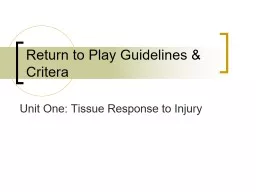

Critera Unit One Tissue Response to Injury Intro A study has indicated the reinjury rate for high school athletes who dont have a Certified Athletic Trainer is 70 The reinjury rate for high school athletes who do have an Athletic Trainer is only ID: 793801
Download The PPT/PDF document "Return to Play Guidelines &" is the property of its rightful owner. Permission is granted to download and print the materials on this web site for personal, non-commercial use only, and to display it on your personal computer provided you do not modify the materials and that you retain all copyright notices contained in the materials. By downloading content from our website, you accept the terms of this agreement.
Slide1
Return to Play Guidelines & Critera
Unit One: Tissue Response to Injury
Slide2Intro
A study has indicated the re-injury rate for high school athletes who
don’t
have a Certified Athletic Trainer is
70%.
The re-injury rate for high school athletes who do have an Athletic Trainer is only
3%.
Why do you think there is such a big difference?
Slide3Objectives
Define Return to Play Terminology.
Identify Return to Play Steps.
Slide4Return to Play
The process an injured athlete goes through in order to safely resume sports competition.
Slide5How do you decide?
If you were the athletic trainer or doctor, when would you release an athlete to return to play?
What would it take?
List the steps that the athlete would need to complete before returning to sports.
Slide6Return to Play
Immobilization
Range of Motion
Basic Strength
Balance, Speed, Power, and Agility
Sport-specific function
Partial Return to Play
Full Return to Play
Slide7Immobilization
The
period of time an athlete’s injury is held still in a cast
, brace, sling, or splint
in order for adequate healing to occur
.
Slide8Range of Motion
The
ability of the injured muscles & tissue to stretch far enough to allow the joint to complete its full
ROM
.
Slide9Basic Strength
Muscles with an injury must be able to produce force equivalent
to at least 95% their
pre-injured
state.Why would this matter?
Slide10Speed
The
ability of the athlete to cover ground quickly
.
What other exercises could an athlete do to help with speed for a shoulder injury?
Slide11Sport Specific Function
The
athlete’s ability to demonstrate skills and movement required in
their sport
.
Cutting, ladders drills, side shuffles, squatting
Slide12Partial Return to Play
The
injured athlete is released to participate in some, but not all practice activities
.
Restrictions might include contact drills, abrupt changes in direction, over-exertion, etc.
Restrictions are dependent on the type and nature of the athlete’s injury and the level of rehabilitation progress
.
Slide13Full Return to play
Release to all practices and competitions without limitations or restrictions
Slide14Recall the steps
What are the 6 steps to return an athlete back to play?
Immobilization
Range of Motion
Basic Strength
Balance, Speed, Power, and Agility
Partial Return to Play
Full Return to Play
Slide15Criteria
What does “criteria” mean to you?
The specific level of the injured athlete must attain & demonstrate in order to progress to the next return to play step.
Slide16Immobilization to Range of Motion Criteria
Sufficient healing time recommended by the physician or athletic trainer before the removal of brace, cast, sling or splint
What would happen if we started ROM exercises too early?
Slide17Range of Motion to Basic Strength Criteria
90%
of normal ROM must be restored
before
beginning strengthening exercises
Slide18Range of Motion
The ability of the injured muscles & tissue to stretch far enough to allow the joint to complete its full range of motion.
Slide19Basic Strength to Agility, Balance, Power, & Speed Criteria
Must have 90% of basic strength before beginning Agility, Speed and Power exercises
Slide20Agility, Balance, Power, & Speed to Sport-Specific Function Criteria
90% of Agility, power and speed before beginning Sport Specific Function
Slide21Sport-specific Function to Partial Return to Play Criteria
Athlete needs to demonstrate ability to perform skills necessary to participate in his/her sport
Slide22Partial Return to Play to Full Return to Play Criteria
Athlete is able to participate in limited practice without pain and no evidence of post-exercise swelling
Slide23Full Return to play
Release to all practices and competitions without limitations or restrictions
Slide24What’s the criteria?
The athlete has 90% pre-injury strength. What can he progress to?
Strength Agility, power, balance & speed
Slide25What’s the Criteria?
The athlete can now demonstrate full function with sport specific drills.
Sport specific function Partial Return
Slide26What’s the criteria?
The cast has been removed by the physician.
Immobilization Range of Motion
Slide27What’s the Criteria?
The athlete has shown no swelling, pain or problems in practice.
Partial return to play Full Return
Slide28Exit Card
On a small sheet of paper:
List the steps to Return to Play
IN ORDER.